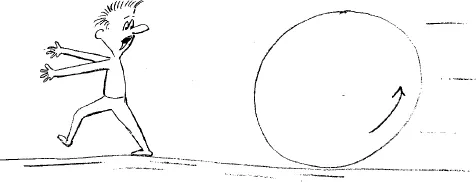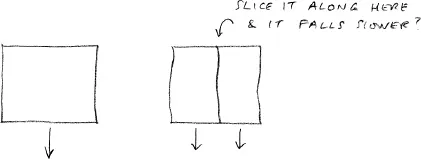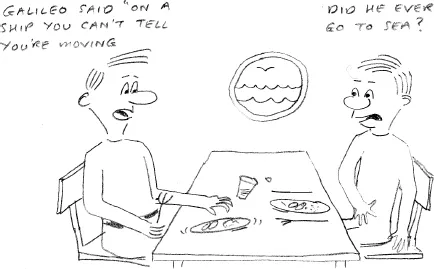![]()
Chapter 1
A History of Inertia
Aristotle
The property that we now call inertia (explained very clearly by Feynman’s father in the quotation) remained hidden from view for a long time. The Greek philosopher Aristotle, for example, said that after a force is applied to objects, they tend to come to a rest after a while, unless a force is continually applied (Aristotle, 330BC, Physics). He thought that the natural state was one of rest. This is a natural idea to have since most things in our experience are at rest, and of course for humans the effortless state is one at rest. It takes some effort to get up and go get a beer from the fridge, so it is easy to assume nature behaves the same way. Based on this assumption (the default state is zero velocity), Aristotle argued that the Earth did not move. He said that when you throw something up into the air it lands on the same place it was thrown from and if the Earth was moving the thrown object would be left behind by the spinning Earth and land elsewhere.
Aristotle was a relatively good observer, but at this time Greek science had not progressed towards the idea of experiment, a process by which physicists find ways to purge most other influences from a system so that the influence you want to look at stands out undiluted. One example of such an experiment is Feynman’s wagon, a ball rolling in a wagon feels less friction, so other effects, like inertia, are more apparent in its behaviour.
At the moment I am writing this I am watching the SpaceX Dragon spacecraft as it attempts to dock with the International Space Station, and this is a good example of an inadvertent inertial experiment since in space there is no air to cause drag so the motion of the Dragon very clearly shows that things keep going at a constant speed if there is no force applied (forgetting for a moment the elliptical orbit which is due to the gravitational force pulling the Dragon towards the Earth). When Dragon fires its engines, and these long bursts of light are clearly visible in the live video, it does change the speed of the spacecraft and they have to be careful they don’t coast forward too far at constant velocity and bang into the ISS. So the default state is not rest, but constant speed. Aristotle did not have access to experiments in the vacuum of space, but he could conceivably have used rolling balls.
Figure 1. The accepted natural state of motion is a constant velocity. People have an intuitive understanding of this, see the cartoon above, but it was first brought into physics by Galileo Galilei.
Galileo
It was Galileo who first combined the experimental method with mathematical rigour. Galileo had been trained in music from an early age and because of that he became interested in mathematics, and this was a great advantage. Mathematics allows you to prove things in a far more objective way: it keeps you honest. The ancient Greeks tended to think that one could arrive at the truth through debate, but ordinary language is vague enough that mistakes can be hidden in nuance and definitions, and it is too easy for glib fellows to win arguments through charisma or cheap tricks.
As an example, one early argument of Galileo’s time (see White, 2007, p44) involved a hail storm that occurred in Pisa shortly after he moved there. His colleagues cited Aristotle’s ideas in which heavier objects dropped from an equal height were supposed to accelerate more rapidly and hit the ground first. Galileo pointed out that this had not been observed, large and small hail stones had hit the ground at the same time. His opponents (including the then famous academic Girolamo Borro) then said that this did not contradict Aristotle since the smaller ones must have started from a lesser height. This is a very good example of something that also happens today, the ad hoc rearrangement of unknown quantities to save a popular theory. The clue back then was the arbitrary way Galileo’s opponents had to arrange the differently-sized hailstones to agree with the observation of an equal fall time: there was no reason for it. There is similarly no reason known for the distribution of dark matter in a halo round galaxies (but more on this later).
Galileo, annoyed by the slippery nature of his opponents’ arguments, used a nice thought experiment to prove that stones of different weight fall at the same speed. He first assumed that the opposite was the case, and disproved this possibility logically as follows: consider a stone A falling (see Figure 2, left). Now break it into two halves B and C (Figure 2, right). If Aristotle is right then both B and C will fall slower than A. But B and C together constitute A. Therefore this implies that A will fall slower than itself! The only way to resolve this paradox is to assume that all stones fall at the same speed (see also Hoffman, 1906, p25). At the time it was difficult to prove this experimentally, since accurate clocks did not yet exist and falling objects move too fast to be easily timed. Galileo solved this problem by rolling balls down inclined planes, this reduced the apparent force of gravity since only a small component of gravity was directed down the slope, and he timed these “slow motion” experiments using a water clock. He showed that all the balls accelerated equally irrespective of their mass.
Figure 2. Galileo’s argument that different masses fall at the same rates by reductio ad absurdum. Consider first the theory of Aristotle that heavier objects fall faster. Consider a large block falling (on the left). Now cut it in two down the centre with a laser, without applying any significant external force. Suddenly you have two blocks falling of half the weight so Aristotle would predict they should suddenly fall less fast, but there has been no force applied! Galileo said the only consistent thing we can assume is that fall speed is independent of mass (of course, neglecting air resistance).
This flatly contradicted Aristotle, who had claimed that a 100 pound ball falling from 100 cubits (58 metres) height would hit the ground before a 1 pound ball could fall one cubit (White, p59). Girolamo Borro, then the most famous academic in Pisa tried this experiment and confirmed Aristotle’s prediction. Galileo tried the experiment himself and disagreed (White, p59).
We now know (within the accuracy of experiments) that objects fall together irrespective of their mass. This is because although heavier objects are more attracted to the Earth due to their greater gravitational mass, they also have more inertial mass and so find it harder to accelerate (see Figure 3). These two effects cancel (although in this book I will try to convince you that things are slightly more complex). This was demonstrated elegantly, although not particularly rigorously, by the Apollo astronaut David Scott when he went to the Moon. The Moon has no atmosphere so when he dropped a hammer and a feather there they hit the lunar surface together.
Galileo also discovered the law of inertia (which can be summarised by saying that the default acceleration is zero). He tried several experiments with V shaped planes and found that if the balls were rolled down from a height H, on one side of the V, then they would rise to the height H on the other side. This is a consequence of the conservation of energy which can be written:
The potential energy an object has is due to its being high up in a gravitational field, so it has the potential to move, and the kinetic energy it has is because of movement and the energy that can be released when it is stopped. The balls start with lots of potential energy (PE) because of their height, convert this potential energy to kinetic energy (KE) as they roll down one side of the V and then are able to climb up the other side of the V by converting the kinetic energy back into potential energy. Some energy is always lost in this process and becomes internal energy — i.e.: heat. Galileo asked what would happen if the second half of the V was horizontal? Then the ball would be able to keep all the kinetic energy it converted from its initial potential energy and would roll horizontally forever! In reality, the ball would eventually stop due to the energy lost to internal energy (heat) which we call friction, but Galileo realised that this friction had for millennia obscured the basic law which was that things keep going. More formally, the principle of inertia is as follows:
A moving body will continue in the same direction unless disturbed.
Figure 3. The principle of equivalence. Objects with more mass (left) are attracted more by the gravity of the Earth, but also have more inertial mass so find it more difficult to accelerate given the same force. The assumption then is that the up and down arrows are always equal in length. This means acceleration is independent of the mass — the amount of ‘stuff’ in the object.
This is also true of “A ball rolling on a level surface...” but anyway, this is the model that is demanded by Feynman’s wagon experiment and it could have been found out by the Greeks if they had had a modern kind of experimental attitude or had been keen bowls players. It shows that the appropriate question to ask is not “what makes it go” since going is the natural state, as the Greeks did, but rather “what makes it stop” (Feynman, 1985) since it is stopping that requires the input energy.
This principle of inertia is important because it defeated Aristotle’s objection to the moving Earth. Although Copernicus had already proposed that the Earth moved before Galileo found his law of inertia, it had been thought that if the Earth moved then everything on it would have fallen behind to maintain their default position. Now it was understood that the important thing was not the default position, but rather the default velocity and so long as this did not change then the Earth could move along at a constant speed and happily drag trees, water and philosophers along with it. This does not yet consider acceleration, but Galileo’s inertia helped to make Copernicus’ hypothesis more plausible and helped the more mathematical models of it derived later by Kepler and Newton.
Galileo made this slightly more general by using the example of a sailing ship. On board a ship travelling at a constant speed the laws of dynamics work just the way they do in an unmoving reference frame, say on land, because the default state of matter is a constant velocity (zero acceleration) and not a fixed place, so one cannot tell whether one is moving by any dynamics experiment onboard the ship, but only by looking outside. Einstein later extended this to include electromagnetic experiments on the ship (this is special relativity) and accelerated motions (with general relativity).
Newton
Isaac Newton was born on Christmas day, 1642 in Woolsthorp, near Grantham in England, and he could be said to have invented modern physics since he was an expert in the use of experiment to isolate systems so they could be studied and the subsequent application of rigid mathematics, after the observations have been completed, to describe the system. He was good at both occupations. In his first law of motion, Newton stated the law of inertia that he got from Galileo like this:
Figure 4. In an inertial (unaccelerated) reference frame, for example on a ship moving at a constant speed on a flat sea, the laws of physics are the same as they would be in a static ship, so one cannot tell you are on a moving ship if there is no way to look outside. That is the theory of Galilean relativity, but it only applies to a ship on a perfectly calm sea. As any sailor knows the reality is that surface waves make the ship accelerate, so inertial frames rarely occur.
Unless acted upon by a net unbalanced force, an object will maintain a constant velocity.
More crucially, he began to apply it mathematically to objects in space, like the Moon, where, because of the lack of friction, it is more obviously valid than on the Earth. Galileo did not make a distinction between gravitational mass and inertial mass. This was done by Newton. Richer provided a clue when he found that the period of oscillation of a pendulum could be increased by taking it from Paris to Cayenne in French Guyana (Bradley, 1971, p107). The period of a pendulum is given by
where L is the length of the pendulum, and g is the acceleration due to gravity. At the equator, the centrifugal outwards force due to the Earth’s rotation counters the acceleration due to gravity (g) so that it appears to be slightly less, so the period (T) of a pendulum is greater. The amount of mass, defined as: density × volume, in the pendulum was the same, but its dynamics (the force on it) had changed.
Since bodies with different weights (balls, feathers) have equal acceleration, then it is clear that acceleration is not just proportional to the force on something (weight) and we...






